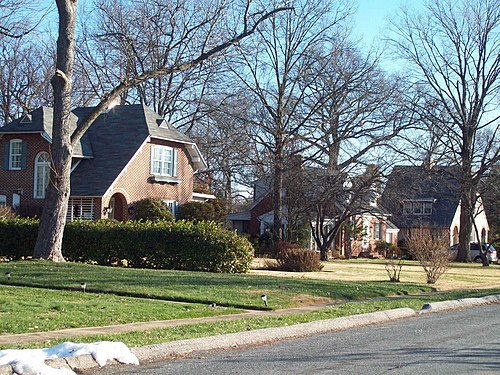Linthicum, Maryland | |
|---|---|
 A street in Historic Linthicum Heights | |
 Location of Linthicum, Maryland | |
| Coordinates:39°12′14″N76°39′38″W / 39.20389°N 76.66056°W /39.20389; -76.66056 | |
| Country |  United States United States |
| State |  Maryland Maryland |
| County |  Anne Arundel Anne Arundel |
| Area | |
• Total | 5.51 sq mi (14.26 km2) |
| • Land | 5.46 sq mi (14.15 km2) |
| • Water | 0.046 sq mi (0.12 km2) |
| Elevation | 138 ft (42 m) |
| Population (2020) | |
• Total | 11,190 |
| • Density | 2,048.6/sq mi (790.96/km2) |
| Time zone | UTC−5 (Eastern (EST)) |
| • Summer (DST) | UTC−4 (EDT) |
| ZIP code | 21090 |
| Area code | 410 |
| FIPS code | 24-47125 |
| GNIS feature ID | 1710221 |
| U.S. Registered Historic District | |
Linthicum is acensus-designated place (CDP) andunincorporated community inAnne Arundel County,Maryland, United States. The population was 10,324 at the 2010 census.[2] It is located directly north ofBaltimore–Washington International Thurgood Marshall Airport (BWI).
Designated as "Linthicum Heights" and zip code 21090 by theU.S. Postal Service, Linthicum has been traditionally divided into two distinct communities each with its own community association and identity. These two communities, split by theBaltimore Beltway in 1957, are Linthicum and North Linthicum (or, alternatively, Linthicum-Shipley and North Linthicum.) Both communities developed as a result of their locations adjacent to theBaltimore and Annapolis Short Line railroad which brought commuters to the originaltruck farming community.
As a developed community, Linthicum began with the 1908 founding of the "Linthicum Heights Company", though a "Linthicum" or "Linthicum's" station on the 1887 Annapolis and Baltimore Short Line railroad existed at least as early as 1889. The community's name was from the area's primary land-owning family since an 1801 purchase by Abner Linthicum.[3]
TheLinthicum Heights Historic District was listed on theNational Register of Historic Places in 2006.[4]
Linthicum is located at39°12′14″N76°39′38″W / 39.20389°N 76.66056°W /39.20389; -76.66056 (39.203876, −76.660506)[5] in northern Anne Arundel County. It extends from thePatapsco River in the north (theBaltimore County line) toMaryland Route 170 (Aviation Boulevard) in the south, and fromInterstate 195 in the west toMaryland Route 648 (Baltimore Annapolis Boulevard) in the east. It is bordered by the CDPs ofBaltimore Highlands to the north (in Baltimore County),Brooklyn Park to the east, andFerndale to the southeast, and by the Baltimore–Washington International Airport to the south.
TheBWI Business District West Nursery area is located in Linthicum along the West Nursery Road corridor. The business district is home to numerous companies, offices, and commercial services.
Two major highways run through the CDP. The Baltimore Beltway (Interstate 695) runs northwest–southeast through Linthicum and intersects with theBaltimore–Washington Parkway (Maryland Route 295), which runs northeast-southwest. By the parkway it is 6 miles (10 km) northeast to downtownBaltimore and 32 miles (51 km) southwest toWashington, D.C.
According to theUnited States Census Bureau, the CDP has a total area of 5.5 square miles (14.3 km2), of which 5.4 square miles (14.1 km2) is land and 0.039 square miles (0.1 km2), or 0.81%, is water.[2]
| Census | Pop. | Note | %± |
|---|---|---|---|
| 2000 | 7,539 | — | |
| 2010 | 10,324 | 36.9% | |
| 2020 | 11,190 | 8.4% | |
| U.S. Decennial Census[6] | |||
As of thecensus[7] of 2000, there were 7,539 people, 2,877 households, and 2,206 families residing in the CDP. The population density was 1,793.1 inhabitants per square mile (692.3/km2). There were 2,950 housing units at an average density of 701.6 per square mile (270.9/km2). The racial makeup of the CDP was 94.39%White, 1.76%African American, 0.24%Native American, 2.44%Asian, 0.15%Pacific Islander, 0.23% fromother races, and 0.80% from two or more races.Hispanic orLatino of any race were 0.89% of the population.
There were 2,877 households, out of which 28.3% had children under the age of 18 living with them, 64.3% weremarried couples living together, 8.7% had a female householder with no husband present, and 23.3% were non-families. 19.5% of all households were made up of individuals, and 10.5% had someone living alone who was 65 years of age or older. The average household size was 2.61 and the average family size was 2.98.
In the CDP, the population was spread out, with 21.3% under the age of 18, 6.2% from 18 to 24, 25.5% from 25 to 44, 26.4% from 45 to 64, and 20.6% who were 65 years of age or older. The median age was 43 years. For every 100 females, there were 93.0 males. For every 100 females age 18 and over, there were 91.7 males.
The median income for a household in the CDP was $61,479, and the median income for a family was $72,821. Males had a median income of $46,586 versus $35,104 for females. Theper capita income for the CDP was $27,559. About 2.0% of families and 3.6% of the population were below thepoverty line, including 3.1% of those under age 18 and 7.8% of those age 65 or over.
Ciena andNorthrop Grumman Electronic Systems are among the companies based in Linthicum.

Linthicum is served by buses and three stops on theBaltimore Light Rail:
From 1887 to February 1950, Linthicum was served by the now-defunctBaltimore and Annapolis Railroad's line between Baltimore andAnnapolis, Maryland.
The community of North Linthicum is defined by the North Linthicum Improvement Association as the area bounded by thePatapsco River from the Baltimore Beltway (I-695) to Old Annapolis Road (MD 648), Old Annapolis Road from the Patapsco River to the Baltimore Beltway, the Baltimore Beltway from Old Annapolis Road to theBaltimore–Washington Parkway, the Baltimore–Washington Parkway from the Baltimore Beltway to Hammonds Ferry Road, and Hammonds Ferry Road from the Baltimore–Washington Parkway to the Patapsco River.

This sectiondoes notcite anysources. Please helpimprove this section byadding citations to reliable sources. Unsourced material may be challenged andremoved.(January 2020) (Learn how and when to remove this message) |